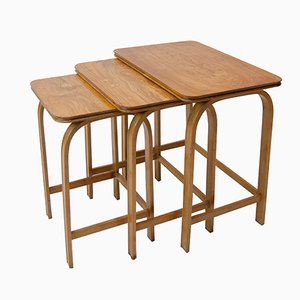
Interior architect and furniture designer Axel Larsson was born in 1898 in Medelpad, Sweden. Educated at Högre Konstindustriell Skolan (1916-1920) and mentored under Carl Malmsten during the Stockholm City Hall project (1919-1920), Larsson spent the first half of the 1920s cultivating his design sensibility amid European study trips before being hired by Svenska Möbelfabrikerna Bodafors’ (SMF) in 1925 in Stockholm. A precocious talent, Larsson stature within the company swiftly grew, and within a few short years, he was appointed SMF’s Head Designer—likely in response to Larsson’s tour de force debut on the international design stage at the 1930 Stockholm Exhibition. There, representing Bodafors, Larsson presented an array of functionalist-inspired furnishings, both strikingly simple and timeless, including a particularly well-received dark birch chair with braided hemp webbing.
While overshadowed by the slightly flashier work of contemporaries like Malmsten, Josef Frank, and Bruno Mathsson, Larsson continued a consistent and influential output into the midcentury. His post-1930 portfolio at Bodafors was particularly notable for interior design commissions for the Gothenburg Concert Hall and the Folksamhuset in Stockholm, along with the approximately 500 furniture lines he designed for mass-production. These collections—which included high-quality and refined cabinets, credenzas, chairs, other casegoods, all crafted from trademark Scandinavian blonde woods—essentially revolutionized how the Nordic region mass-manufactured furniture, introducing new methods and standards.
After over thirty years with the company, Larsson left Bodafors in 1956 to start his own firm but continued to collaborate with his former employer throughout the coda stages of his career. This twilight span saw Larsson work with a number of Sweden-based firms, including the Swedish Handicraft Association and Balzar Beskow AB, which continues to produce Larsson’s stackable S-312 Chair today.
He passed away in 1975.


